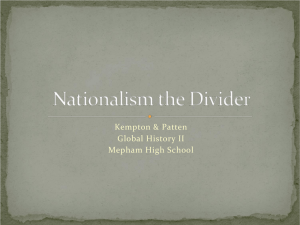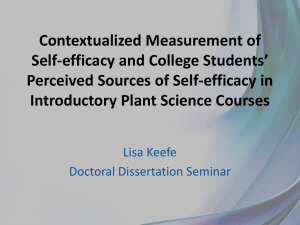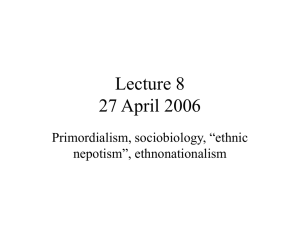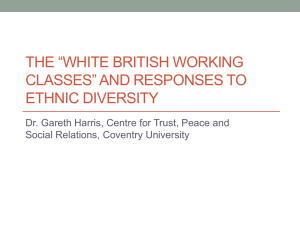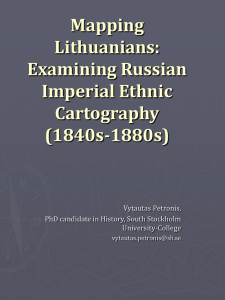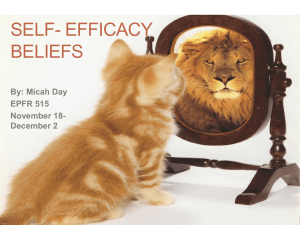The Role of Self-Efficacy, Social Connectedness and Identity
advertisement
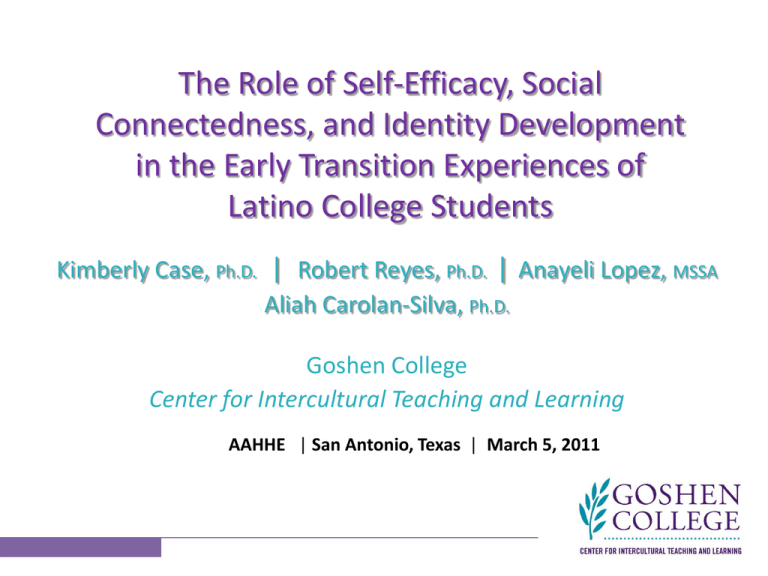
The Role of Self-Efficacy, Social Connectedness, and Identity Development in the Early Transition Experiences of Latino College Students Kimberly Case, Ph.D. | Robert Reyes, Ph.D. | Anayeli Lopez, MSSA Aliah Carolan-Silva, Ph.D. Goshen College Center for Intercultural Teaching and Learning AAHHE | San Antonio, Texas | March 5, 2011 Session Outline • • • • Overview of CITL at Goshen College The SALT Program Conceptual frameworks informing efforts Observed gains in Latino students as they transition to college • How SALT students compare to other students CITL Center for Intercultural Teaching and Learning • Research • Community Outreach • College Student Success Four-Year Cohort Program • 1st Year: Exploring who I am • 2nd Year: Contributing to my campus as an ethnically diverse student • 3rd Year: Enacting servant leadership and exploring social justice • 4th Year: Preparing for an intercultural workplace SALT YEAR 4 Higher level of integration; preparing for an intercultural workplace YEAR 1 Exploring who I am: Ethnic Identity Exploration YEAR 3 YEAR 2 Enacting servant leadership in the community and exploring social justice Contributing to my campus as an ethnically diverse student SALT Summer Academic Leadership Training • 2nd year at Goshen College; 3 week program • 3 academic credits • Development of: • academic skills: courses; field trips; research lab • social adjustment: roommates; on-campus living; interaction with faculty, students, staff • personal awareness: fieldtrips; course content SALT Daily Schedule 8am 9am-12pm Breakfast Class [Oral Comm. / Lit. & Writing] 12pm 1-3pm 3pm 3:30-5pm 5pm Lunch Proctored study time Break Math or Research Lab Dinner SALT – Additional Components Evening activities Social activities Trips Misc. Residence Hall Meetings Leadership Seminar (also leadership lunch gatherings) Worship Chicago: National Museum of Mexican Art Cincinnati: National Underground Railroad Freedom Center Indianapolis Chief Ice Cream Outing Scavenger Hunt Movie Night Celebration Coffee House Registration for classes Tutoring available in dorm Residence Life: 3 resident assistants and resident director SALT 2010 Participants • Ethnicity 15 Hispanic 2 African American 1 Asian 2 African (international) 1 White • 10 CITL students; 12 ALANA students • 11 women; 10 men • 9 first-generation college students Conceptual Frameworks College Self-Efficacy Self-efficacy is not simply possession of a skill, but the belief that the skill can be effectively produced under a variety of circumstances. Four Determinants • Enactive attainments (mastery experiences) • Vicarious experiences (watching a model perform a task) • Verbal persuasion (encouragement to engage in a target behavior) • Physiological arousal (use of arousal information) Bandura, 1994 College Self-Efficacy Can I succeed in college? In academic settings, self-efficacy refers to students’ confidence in their ability to carry out college-related tasks: • Academic: talking to professors, writing a term paper • Social: making new friends, joining a student organization • Relational/roommate: socializing with others you live with (Solberg, O’Brien, Villareal, & Davis, 1993) Social Connectedness • How students view themselves in relation to friends, strangers, peers, and their world (Lee & Robbins, 2000) • High social connectedness: can easily identify with other people, view others as approachable and friendly, participate in activities and social groups (Lee, Draper & Lee, 2001) • Low social connectedness: lower self-esteem, less satisfaction with relationships, and perceive environments as more threatening (Lee & Robbins, 1998) Ethnic Identity Development • Ethnic Identity Development: The process of the search of identity with a particular ethnic group(s). “Ethnic identity refers to one’s sense of belonging to an ethnic group and the part of one’s thinking, perceptions, feelings, and behavior that is due to ethnic group membership” (Phinney, 1996). • Unexamined, Exploration, Achieved • Enclaves (Kuh & Love, 2000) – Bridging the cultural distance between students of color and the larger predominantly White campus (Rodgers & Summers, 2008) Ethnic Identity Development Phinney (1992) Multigroup Ethnic Identity Measure • Ethnic identity search (developmental and cognitive): Individual’s degree of engagement in exploring their ethnic identity. • Affirmation: Sense of pride individuals feel towards their ethnic group. • Belonging: Degree of attachment individuals have towards their own ethnic group. • Commitment: Strength of individuals’ ties towards their ethnic group. SALT 2010 video… Assessing Outcomes • SALT - initial venue for increasing students’ college self-efficacy, social connectedness and ethnic identity awareness • Developing a logic model to guide the process • Program evaluation utilizing surveys and interviews – Feedback on program delivery – Answering research-focused questions Research Question What contributions do self-efficacy, social connectedness, and identity development make to the experience of Latina and Latino students in their initial transition college? Findings Academic Self-Efficacy College Self-Efficacy Inventory (Solberg, O’Brien, Villareal, & Davis, 1993) – Sub-scales: • Academic • Roommate • Social INTERVENTIONS • Class, proctored study, tutoring in dorms, RA (role models) Please answer how confident you are that you can successfully complete each task. 0=totally unconfident; 1=very unconfident; 2=unconfident; 3=somewhat unconfident; 4=undecided; 5=somewhat confident; 6=confident; 7=very confident; 8=totally confident College Self-Efficacy Inventory 8 7 6 5 4 3 2 1 0 Pre-test Post-test Academic 5.48 5.74 Roommate 6.52 6.67 Social 6.15 6.44 Self-Efficacy Realistic Expectations for College • I’m glad I got to have that experience now. And I have an idea what it’s gonna be like in August. • So I think the program has really helped with, opening people’s eyes and making them realize that, you know, this is college and a head start is really good. • SALT was very helpful in seeing how the workload is gonna be. And how much time you need to dedicate, and seeing what kind of organization you’re gonna have to put into your studyin’. Self-Efficacy Mastery of Academic Experiences • …I won’t be as scared to ask teachers for help and then ask like my friends or something, people I meet in the class, ask them for help as well. • I now feel more comfortable speaking in front of other people, I can present and feel confident that I know what I am doing. • [SALT class has] given us an idea of, what teachers are expecting from us. And, how to get involved, like in class discussions and all that. Self-Efficacy Social Behaviors in/out of the Classroom • I think if I have an opinion I’m very ready to get into that [classroom discussions and asking questions]. And I think the SALT program is actually really helpful. I don’t know if I would have been, you know, this confident without the SALT program. • What I liked most about the class… The fact that the teacher and us (the students) became comfortable with each other, and in oral communications that’s important. It prepared me well of what to expect. • …How to manage my time, and believe in myself that I can do it. Social Connectedness • Social Connectedness ScaleRevised [SCS-R] • INTERVENTIONS – Living on campus 3 weeks – Cohort model, structured experience – Shared out-of-class experiences – Building relationships with faculty, staff, and students Social Connectedness Global orientation General social relations Peers & close relationships Self Social Connectedness Categories 5 4 3 Negatively worded items +0.13 2 1 +0.30 +0.23 +0.14 0 Self Peers & Close Relationships Pre-test General Social Relations Post-test Global Orientation Social Connectedness General Social Relations • Well, I’m more excited because this is only like a three week program and it was only with a couple people and I’ve met so many people and made so many, like new friendships. • I’m excited to just like meet more people next year since there’s like all their dormitories are gonna be filled and there’s gonna be a variety of people here. • [SALT has] prepared me like, how I’m gonna approach people and talk to them. Social Connectedness Peer & Close Relationships (dorm) • I wasn’t really into this idea of, sharing a room with somebody who I didn’t know at all. But now we’re really close to each other….in these short three weeks, we’ve become, like very close so. I know with her I will have a really good relationship too. • …there’s a sense of community in the dorms. People come and hang out all the time. And, people hang out in the Connectors. There’s just, there’s a big sense of community within the dorms as well. Social Connectedness Peer and Close Relationships • And this program has allowed me to meet people before school, so I kind of know who to ask for help or like who to call up when I’m bored or something. • It was nice knowing that, I don’t need to be scared about making friends. That was really cool. I was, happy with that. • …over the last three weeks, a lot of us, I think, have very close friends. And I’m gonna definitely miss them. And I think that through the next four years of college that we’ll probably hang out a lot. And we’re actually planning to go to Puerto Rico for Spring Break, a lot of us. Ethnic Identity Development • Multigroup Ethnic Identity Measure 1 = Strongly Disagree 2 = Disagree 3 = Agree 4 = Strongly Agree • INTERVENTIONS: Course content, texts, fieldtrips, peer interaction Multigroup Ethnic Identity Measure TOTAL of all items Ethnic Identity Search 4 Affirmation, Belonging, Commitment 3.5 3 2.5 2 1.5 1 0.5 0 Pre-test Post-test 3.08 3.14 2.78 2.81 3.29 3.38 Ethnic Identity Awareness • I was learning a lot more about myself. • I never had, friendships with other, races. Fieldtrips to the National Museum of Mexican Art and to the Freedom Center… • Challenge my thoughts and made me realize where I come from. • It informed me more about history involving culture. • I was able to relate to them especially the trip to the national museum of Mexican Art. Ethnic Identity Awareness It sounds cliché, but I actually felt like this, this awakening. So like, ever since, the museum part of SALT….I felt more, brown (laugh). Not so much white, so like I’m just kinda like slowly my world has been changing and opening and like, like eating hot sauce with Doritos, like (laughing). Other Evidence Comparison with other students • Program leaders’ anecdotal assessment • SALT participants consistently rated Orientation items higher than the non-SALT comparison group • Retention – SALT – 19 of 22 students returned, 86.4% • All non-returners were not part of the CITL cohort program – Non-SALT Comparison Group – 9 of10 students returned, 90% • GPA… SALT non-CITL M = 2.53 SALT CITL M = 2.86 4 4 3 3 2 2 SALT M = 2.70 1 1 0 0 First Semester GPA Non-SALT Students M = 2.49 4 3 2 1 0 What we have learned and future research… • Bolstering academic components throughout the CITL cohort program • Course selection for SALT • Stronger measures for academic self-efficacy • Examine ethnic identity exploration alongside leadership development • The role of a sense of belonging Questions & Discussion CITL Center For Intercultural Teaching and Learning Goshen College | Goshen, IN 46526 http://citl.goshen.edu/ Thank you for attending the session. References • • • • • • • • • Bandura, A. (1993). Perceived self-efficacy in cognitive development and functioning. Educational Psychologist, 28(2), 117-149. Kuh, G. D., & Love, P. G. (2000). A cultural perspective on student departure. In J. M. Braxton (Ed.), Reworking the student departure puzzle (196-212). Nashville: Vanderbilt University Press. Lee, R. M., Draper, M., & Lee, S. (2001). Social connectedness, dysfunctional interpersonal behaviors, and psychological distress: Testing a mediator model. Journal of Counseling Psychology, 48(3), 310-318. Lee, R.M., & Robbins, S.B. (1998). The relationship between social connectedness and anxiety, selfesteem, and social identity. Journal of Counseling Psychology, 78, 484-491. Lee, R.M., & Robbins, S.B. (2000). Understanding social connectedness in college women and men. Journal of Counseling and Development, 78, 484-491. Phinney, J. (1992). The Multigroup Ethnic Identity Measure: A new scale for use with adolescents and young adults from diverse groups. Journal of Adolescent Research, 7, 156-176. Phinney, J. (1996). When we talk about American ethnic groups, what do we mean? American Psychologist, 51, 918-927. Rodgers, K. A., & Summers, J. J. (2008). African American students at predominantly White institution: Towards a revised retention model. Educational Psychology Review, 20(2), 171–190. Solberg, V. S., O’Brien, K., Villareal, R. K., & Davis, B., (1993). Self-efficacy and Hispanic college students: Validation of the college self-efficacy instrument. Hispanic Journal of Behavioral Sciences, 15(1): 80-95.

